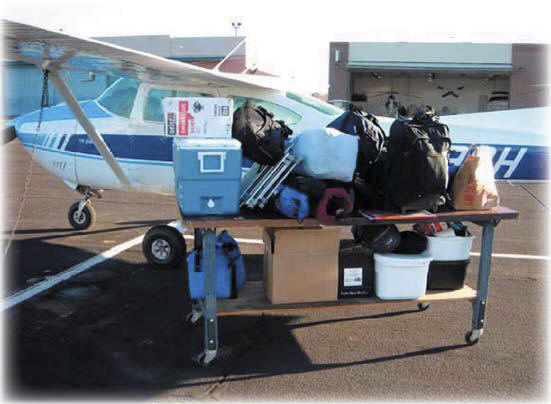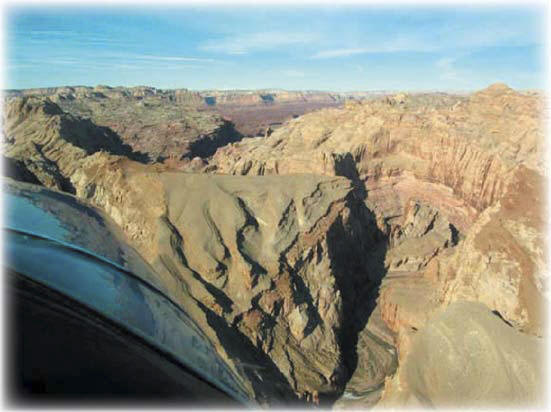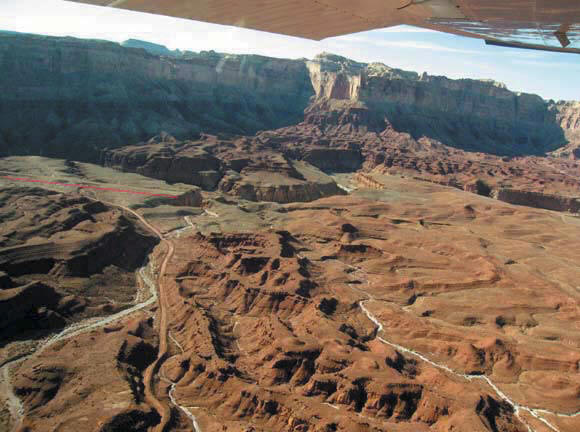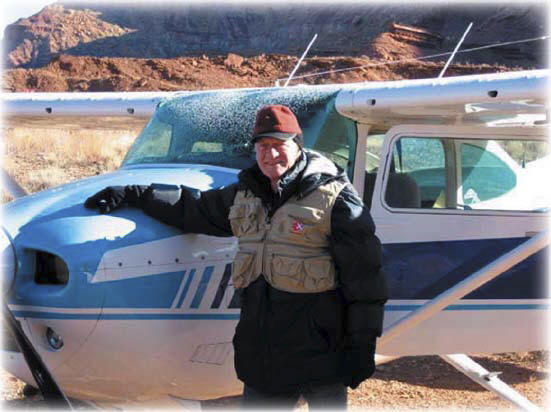Frozen Splendor
I Froze my Patootie Off
I froze my patootie off. I don’t know where I can get a new one. I
even checked e-Bay to no avail.
 You
might think this is a difficult proposition or even a preposterous
statement, but let me explain.
You
might think this is a difficult proposition or even a preposterous
statement, but let me explain.
I spend time flying with my friend, Gary McDonald of Santa Rosa, Calif., several times each year. This relationship began with mountain flight training in the Idaho backcountry where we found we “click” together and enjoy getting away from the rigors of work.
We were flying around the Tetons last summer when we decided to go fishing and camping in the Idaho backcountry.
Taking a break to enjoy a leisurely lunch, we decided to have the best experience possible so we called our friend Galen Hanselman. Galen wrote the books, Fly Idaho!, Fly the Big Sky! and Fly Baja! If anyone knows the Idaho backcountry it is Galen.
Our buddy was queried about the best fishing areas. Gary could hear my side of the conversation. When I said, “Soldier Bar,” he cringed. Another overheard word, “rattlesnakes” seemed however to have piqued his interest. Gary had only been to Soldier Bar once. I recall it was late in the afternoon of a hot summer day. Soldier Bar is considered a one-way strip with landing to the west. This landing proved to be a real challenge because of the blinding effect of the setting sun. After parking the airplane Gary got out and kissed the ground.
It was 93ºF when we departed so the takeoff required quite a bit of the available runway. Needless to say, Soldier Bar wasn’t one of Gary’s favorite strips. We ended up camping at Upper Loon. After two weeks of flying and camping in the Idaho backcountry with a side excursion to AirVenture in Oshkosh, Gary had to return to work designing and installing custom rock pools and waterfalls.
Teton Mountains, Jackson, Wyo.
 So
when Gary called during the first part of November to arrange
another get-away we decided to head for southern Utah. Who else to
rely on for information but our buddy Galen? This is the same guy
that told us fishing at Soldier Bar was fantastic … “just look out
for the rattlesnakes while hiking the 500-vertical feet down to the
river.”
So
when Gary called during the first part of November to arrange
another get-away we decided to head for southern Utah. Who else to
rely on for information but our buddy Galen? This is the same guy
that told us fishing at Soldier Bar was fantastic … “just look out
for the rattlesnakes while hiking the 500-vertical feet down to the
river.”
Landing at Happy Canyon airstrip, Utah
It is difficult for some people to believe that Utah has more backcountry airstrips (282) than Idaho (62), Montana (12), Washington, Oregon and Wyoming combined. Most pilots find them to be ever bit as challenging as the “mountain” backcountry airstrips, with elevations to match. Galen had told us during a summer-get-together at Smiley Creek, Ida. that southern Utah was fantastic. He should know, his new book, Fly Utah! comes out early in 2007. It has to be impossible to match the splendor of Utah’s backcountry airstrips, each with unique characteristics. The airstrips may be next to a snow-capped mountain, or hidden in a canyon with colorful cliffs, spires and petroglyphs, or maybe it is laid out in the high-desert surrounded by pinnacles and arches.
Southern Utah is unequivocally beautiful. Unique, like Utah, is Galen. There isn’t anywhere else where you can dig out the creative perceptions, the inspiring insights, and the outstanding research of an area such as that provided by Galen’s books. Galen cautioned us that it was too hot to camp in Utah during the summer and that the density altitude can challenge the performance of any airplane. He suggested that we should plan going there during the spring or fall.
So we went in the fall … Duh! It’s fall until the beginning of the
winter solstice on December 21. So we felt confident in Galen’s
recommendation. We anticipated a day-time temperature around 50ºF
and nighttime lows of around 30ºF. Mistake. The or iginal
game plan was to meet in St. George, Utah, but my Cessna 180 was at
the airplane hospital for its annual inspection, so Gary flew to
Jackson, Wyo. to pick me up. On December 2nd we loaded Gary’s plane
and headed for southern Utah. As fate would have it–and probably a
load of luck–we got a late start and it was too dark to land at a
backcountry airstrip. Whew! We flew into Page, Ariz. arriving after
dark.
iginal
game plan was to meet in St. George, Utah, but my Cessna 180 was at
the airplane hospital for its annual inspection, so Gary flew to
Jackson, Wyo. to pick me up. On December 2nd we loaded Gary’s plane
and headed for southern Utah. As fate would have it–and probably a
load of luck–we got a late start and it was too dark to land at a
backcountry airstrip. Whew! We flew into Page, Ariz. arriving after
dark.
After a night in Page, I was sure that “camping” in a local motel had acclimated us for the next day’s adventure. Motels in Page are designed for hot weather. The air conditioning works great; the heater is like a being kissed by a dog, it only warms a small spot. During breakfast the next morning we noticed a small candle-like thingamajig on the table. It had a black plastic base that encompassed a plastic jar of Sterno-like fluid and a thick glass top. As a Boy Scout I learned a candle could warm a snow cave, so why wouldn’t it work for a tent? We bought one to take with us.

 The
Cessna 182 (right) was loaded complete with folding aluminum tables
and the proverbial "kitchen sink."
The
Cessna 182 (right) was loaded complete with folding aluminum tables
and the proverbial "kitchen sink."
We got a late start and flew to several strips that we considered for camping. Most were covered with snow so we ended up flying into Hidden Splendor and set up camp. Another mistake! We later re-named this the “Frozen Splendor” airport. The Utah Backcountry Pilots Association warns: “Hidden Splendor, elevation 4,830-feet MSL. This airstrip is usually in good condition, smooth and dry. It is still one of Utah’s most hazardous airstrips. Both ends of the airstrip terminate at a cliff edge so landing either too short or too long would likely be fatal. Parts of the airstrip are also narrow with drop-offs from the edge of the runway. There is rising terrain in every direction. It is a narrow canyon to the southeast. The terrain to the northwest looks gentle but rises at a deceptive rate.”
Angel Point (left) and Dark Canyon/South Rim (right) were both covered in snow with drifts.
 Approaching
the Muddy Creek Canyon southeast of Hidden Splendor airstrip (left).
Approaching
the Muddy Creek Canyon southeast of Hidden Splendor airstrip (left).
We cooked a fantastic
 dinner
of New York strips and Idaho potatoes with onions. As we started
eating the moon was rising over the sheer cliffs to the east. We
actually had about 4/5 of the dinner consumed before the potatoes
froze solid. When the sun goes down it gets a mite chilly. We poured
water in a pan to wash dishes and before we could light the stove,
there was a layer of ice on top. Then it turned really cold. There
is absolutely no firewood at Hidden Splendor and we weren’t smart
enough to take along some Presto logs. Not to fear, we had brought
along our trusty candle apparatus secured from the restaurant. I
slid the air mattresses apart far enough to wedge the candle between
and lit it up. Ah, heat from the top while the sides stayed cool so
there was no fire danger. It turned out there was no heat danger
either; it did not heat the
tent.
dinner
of New York strips and Idaho potatoes with onions. As we started
eating the moon was rising over the sheer cliffs to the east. We
actually had about 4/5 of the dinner consumed before the potatoes
froze solid. When the sun goes down it gets a mite chilly. We poured
water in a pan to wash dishes and before we could light the stove,
there was a layer of ice on top. Then it turned really cold. There
is absolutely no firewood at Hidden Splendor and we weren’t smart
enough to take along some Presto logs. Not to fear, we had brought
along our trusty candle apparatus secured from the restaurant. I
slid the air mattresses apart far enough to wedge the candle between
and lit it up. Ah, heat from the top while the sides stayed cool so
there was no fire danger. It turned out there was no heat danger
either; it did not heat the
tent.
Hidden Splendor airstrip is located above the red line near the left center allowing an unobstructed approach to runway 15.
 Well,
being the brilliant guy that I am, before we went to bed at 7 pm, I
decided it was so cold that we should have a pot of coffee to warm
us up. This was another M-I-S-T-A-K-E … had to get up to pee six
times during the night.
Well,
being the brilliant guy that I am, before we went to bed at 7 pm, I
decided it was so cold that we should have a pot of coffee to warm
us up. This was another M-I-S-T-A-K-E … had to get up to pee six
times during the night.
Camp site at Hidden Splendor before the big freeze (right).
It turns out that arctic conditions exist when the temperature drops below 20ºF, especially if the wind is blowing. Of the 50 States, only seven do not experience arctic conditions … Utah is not one of them!
The night was long and cold. Another mistake was using an air mattress instead of a closed-foam mattress. To solve the dilemma we dug out some “Hotties,” those little packets of granules that you shake up and they produce warmth. They lasted an astounding 11 hours, but they’re really small. I had absconded with three packets from our cache and curled into a fetal position with one under my thigh, one under my hip and one under my shoulder. I was about to grab one more for my hands when Gary said, “You ought to save those for an emergency.” “Emergency?” I gasped, “What do you think this is?” I got up at 6:30 a.m. and hiked around to warm up. It didn’t work. I went down to Muddy Creek and found hard water … in fact, solid water. Because of the cold I was unable to function until around 8:15. When I checked the digital thermometer in the airplane. It was 9ºF/–12.8ºC at that time.
Landing on runway 15. The approach end of the runway is 4,807 feet, rising to 4,834 in the first 350 feet, then tapering to 4,804 at the approach end of runway 33. The total length is 1,800 feet.
Lessons Learned
Do not use an air mattress; the “dead” air below you will chill you to the bone. Use something like a “ThermaRest” sleeping mat, closed-cell foam pad or an eider down mat (Outdoor Research 9 Deluxe down mat). Avoid cotton blue jeans. Don’t put your head inside the sleeping bag as the moisture of breathing turns it wet. Change to dry clothing for sleeping. Wear wool socks and a hat to bed.

Gary trying to warm up before going to bed (left).
Hidden Splendor could pose a problem during the summer months with a
density altitude of 8,500 feet or
 more.
Takeoff from runway 15 leads into a canyon that requires sharp turns
in a narrow area. Standard temperature at Hidden Splendor is 42ºF.
We were well below that with only about one-hour’s fuel burn below
gross weight. We lacked the climb performance necessary to avoid
making sharp turns during departure through about three quarters of
the canyon. Keep the airplane light during the summer! About the
time we thawed out sufficiently to fly the airplane, we swore to
never go camping again during cold weather, but looking back, it
wasn’t so bad. Maybe we should try it again during the January thaw?
more.
Takeoff from runway 15 leads into a canyon that requires sharp turns
in a narrow area. Standard temperature at Hidden Splendor is 42ºF.
We were well below that with only about one-hour’s fuel burn below
gross weight. We lacked the climb performance necessary to avoid
making sharp turns during departure through about three quarters of
the canyon. Keep the airplane light during the summer! About the
time we thawed out sufficiently to fly the airplane, we swore to
never go camping again during cold weather, but looking back, it
wasn’t so bad. Maybe we should try it again during the January thaw?
Anyway if you find an extra patootie, I could use one.

The last turn from Hidden Splendor
airstrip
along Muddy Creek may be impossible to
make in a light airplane at low altitude.
Sparky still trying to thaw out at 10:00 a.m.
-- Note the heavy frost on the plane
(and note the survival vest).
|
|
|

